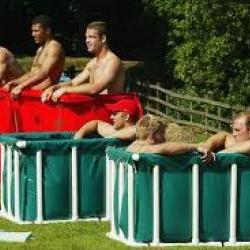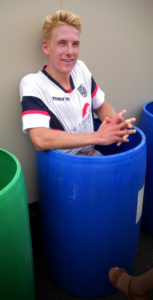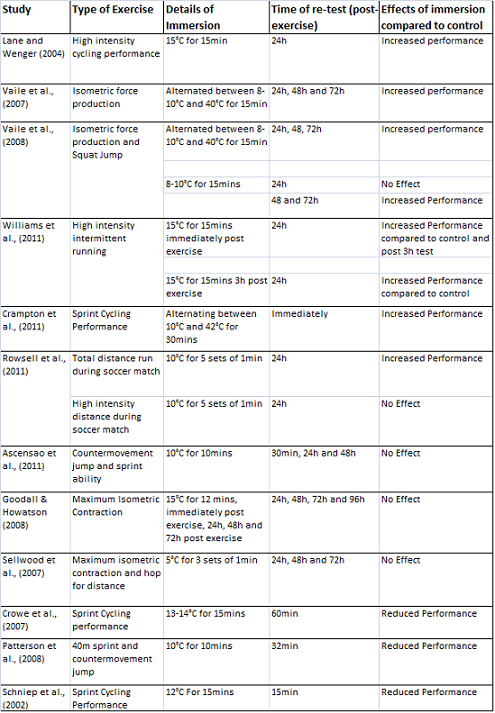Main Menu
Latest Blog Entry
User login
Ice Baths- Giving muscle soreness the cold shoulder?
What is the current thinking on Ice Baths?
Success in sports depends on an athlete’s ability to perform functional movements, such as running, jumping or changing direction, to a high level on a daily basis. However, the fatiguing effect of high intensity competition and training experienced by elite athletes can reduce the quality of performance.

In recent years, ice baths or cold water immersion (CWI) have been used widely in an attempt to help athletes recover following training and competition.
But are they really effective? And what is the correct protocol? We take a look at the research behind the practice.
Reducing Muscle Soreness
One of the potential benefits of CWI is the reduction in muscle soreness associated with intense exercise, otherwise known as delayed onset muscle soreness (DOMS).
There is now a vast body of research which supports the use of CWI following intense exercise to reduce DOMS (1, 3, 6, 10, 11, 17, 18, 19, 20,), with benefits including reduced pain at rest, reduced pain on stretch and increased active range of motion.
Several mechanisms have been suggested to be responsible for this reduced soreness including:
1) Reduced swelling due to hydrostatic pressure of water (20)
2) Reduced swelling due to constriction of blood vessels at low temperature (6)
3) Reduced nerve conduction velocity due to cold temperature, resulting in increased pain tolerance (1)
It is not known for certain which of the mechanisms play the biggest role in relieving soreness.
 However, a recent study (9) comparing different CWI strategies has found that water immersion at 6°C was more effective than both water immersion at 10°C and contrast water immersion alternating between 10°C and 38°C. This would suggest that the cold temperature plays a more important role than the water immersion itself.
However, a recent study (9) comparing different CWI strategies has found that water immersion at 6°C was more effective than both water immersion at 10°C and contrast water immersion alternating between 10°C and 38°C. This would suggest that the cold temperature plays a more important role than the water immersion itself.
This benefit may only exist with trained athletes, and that those new to exercise or performing a new training regime will not see a reduction in muscle soreness.
Recovery of Performance
Despite the benefits of CWI for reducing muscle soreness, the effects on recovery of physical performance are less clear. Numerous studies have examined the effects of CWI on a variety of performance related parameters; however the mixed results make it difficult to draw solid conclusions about its effectiveness.
The table below indicates the discrepancies between studies:
Table 1. Details and results of studies investigating the effects CWI strategies on recovery of performance

Although the results are varied, some patterns do exist across the studies. For instance, the studies which retested performance on the same day seemed to find either no effect or a negative effect. This has been attributed to decreased nerve velocity and also restricted blood flow to the muscle (1, 8).
Whereas studies which tested between 24-48 hours later were more likely to find a positive result, suggesting that CWI could help recovery for next day performance. This could be due to a reduced perception of fatigue and/or a reduction in localised swelling which has been shown to reduce force generation (5).
These could be important implications for the use of CWI in sport. Sportsmen and women in sports involving several bouts of competition within one day such as multi-event Athletics or Rugby Sevens would be advised to abstain from CWI in between bouts.
On the other hand CWI may be beneficial for athletes competing on consecutive days such as Tennis, Cycling or Tournament Football.
Due to the varied nature of the results however, there is no ‘best practice’ which can be advised regarding the use of CWI and so athletes should use with caution on an individualised basis as part of their recovery strategy.
Reducing Adaptation
Despite some research supporting the use of CWI for recovery of short term performance in sport, there are suggestions that long term use could actually have a negative impact on physical adaptation.
Immersion in cold water has been shown to illicit an increase in the stress hormones cortisol and norepinephrine for up to 60minutes post immersion (4). These hormones are catabolic in nature, meaning that they act to break down muscle tissue, which would reduce the body’s ability to adapt to training.
In addition, the reduction in swelling associated with CWI and relieving muscle soreness may also be detrimental to adaptation. MacIntyre and colleagues (13) suggested that:
“the inflammatory response may be responsible for initiating, amplifying, and/or resolving skeletal muscle injury”
They also present evidence of the role of white blood cells in the inflammatory response, which would be significantly reduced during cold water immersion due to the vasoconstriction of localised blood vessels.
Conclusions
The role of cold water immersion in recovery from intense exercise is still unclear. There is strong evidence which suggests muscle soreness resulting from exercise can be reduced in trained athletes, and that this may have a positive effect on performance in the following days.
However the long term effects of cold water immersion on the physical adaptation to exercise remain uncertain. With this in mind, cold water immersion following training should be limited.
Whilst ice baths may look cool and feel nice, there are better and more convenient ways to recover.
Matt Durber
Futher reading:
- The best methods for recovery and how they should be used: The recovery pyramid
References
1) Algafly, A.A., & George, K.P. (2007). The effect of cryotherapy on nerve conduction velocity, pain threshold and pain tolerance. British Journal of Sport Medicine, 41, 365-369.
2) Ascensao, A., Leite, M., Rebelo, A.N., Magalhaes, S. & Magalhaes, J. (2011). Effects of cold water immersion on the recovery of physical performance and muscle damage following a one-off soccer match. Journal of Sports Sciences, 29, 217-225.
3) Bailey, D.M., Erith, S.J., Griffin, P.J., Dowson, A., Brewer, D.S., Gant, N., & Williams, C. (2007). Influence of cold-water immersion on indices of muscle damage following prolonged intermittent shuttle running. Journal of Sports Sciences, 25, 1163-1170.
4) Bleakley, C.M. & Davison, G.W. (2010). What is the biochemical and physiological rationale for using cold-water immersion in sports recovery? A systematic review. British Journal of Sports Medicine, 44, 179-187.
5) Brophy-Williams, N., Landers, G. & Wallman, K. (2011). Effect of immediate and delayed cold water immersion after a high intensity exercise session on subsequent run performance. Journal of Sports Science and Medicine, 10, 665-670.
6) Cochrane, D.J. (2004). Alternating hot and cold water immersion for athlete recovery: A review. Physical Therapy in Sport, 5, 26-32.
7) Crampton, D., Donne, B., Egana, M. & Warmington, S.A. (2011). Sprint cycling performance Is maintained with short-term contrast water immersion. Medicine and Science in Sports and Exercise, 43, 2180-2188.
8) Crowe, M.J., O’Connor, D., & Rudd, D. (2007). Cold water recovery reduces anaerobic performance. International Journal of Sports Medicine, 28, 994-998.
9) University of Ulster (Pre-Publication). Post exercise recovery research.
10) Eston, R., & Peters, D. (1999). Effects of cold water immersion on the symptoms of exercise-induced muscle damage. Journal of Sports Science, 17, 231-238.
11) Goodall, S., & Howatson, G. (2008). The effects of cold water immersions on indices of muscle damage. Journal of Sports Science and Medicine, 7, 235-241.
12) Lane, K.N., & Wenger, H.A. (2004). Effect of selected recovery conditions on performance of repeated bouts of intermittent cycling separated by 24 hours. Journal of Strength and Conditioning Research, 18, 855-860.
13) MacIntyre, D.L., Reid, D.W. & McKenzie, D.C. (1995). Delayed Muscle Soreness. The inflammatory response to muscle injury and its clinical implications. Sports Medicine, 20, 24-40.
14) Patterson, S.M., Udermann, B.E., Doberstein, S.T., & Reinke, D.M. (2008). The effects of cold whirlpool on power, agility and range of motion. Journal of Sports Science and Medicine, 7, 387-394.
15) Rowsell, G.J., Coutts, A.J., Reaburn, P. & Hill-Haas, S. (2011). Effect of post-match cold-water immersion on subsequent match running performance in junior soccer players during tournament play. Journal of Sports Sciences, 29, 1-6.
16) Sellwood, K.L., Brukner, P., Williams, D., Nicol, A., & Hinman, R. (2007). Ice-water immersion and delayed onset muscle soreness: A randomised control trial. British Journal of Sports Medicine, 41, 392-397.
17) Skurvydas, A., Sipaviciene, S., Krutulyte, G., Gailiuniele, A., Stasiulis, A, Mamkus, G., & Stanislovaitis, A. (2006). Cooling of leg muscles affects dynamics of indirect indicators of skeletal muscle damage. Journal of Back and Musculoskeletal Rehabilitation, 19, 141-151.
18) Vaile, J.M., Gill, N.D., & Blazevich, A.J. (2007). The effect of contrast water therapy on symptoms of delayed onset muscle soreness. The Journal of Strength and Conditioning Research, 21, 697-702.
19) Vaile, J.M., Halson, S., Gill, N.D., & Dawson, B. (2008). Effect of hydrotherapy on recovery from fatigue. International Journal of Sports Medicine, 29, 539-544.
20) Wilcock, I.M., Cronin, J.B., & Hing, W.A. (2006). Physiological response to water immersion: A method for recovery? Sports Medicine, 36, 747-765.
Client Testimonials
 Blundells School
Blundells School
James has a huge breath and depth of knowledge on fitness issues. He is able to implement this knowledge into a practical course both making the task of fitness and conditioning both different and interesting from other fitness training that most are familiar with. He understands the safety issues when dealing with young adults strength and conditioning programmes. Programmes he sets are tailored to the individual needs of the group. There was a huge amount of progress made with some of these individuals in terms of their understanding of fitness and their own fitness levels.
More


Comments
[…] progressed, Steve got busier with massage and treatment. Hydration, fuel and recovery (including ice baths) were emphasised and made […]
[…] Ice bath– may be especially beneficial after contact sports or excessive volume. […]